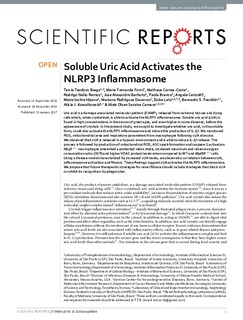| dc.contributor.author | Braga, Tarcio Teodoro | |
| dc.contributor.author | Forni, Maria Fernanda | |
| dc.contributor.author | Correa-Costa, Matheus | |
| dc.contributor.author | Ramos, Rodrigo Nalio | |
| dc.contributor.author | Barbuto, Jose Alexandre | |
| dc.contributor.author | Branco, Paola | |
| dc.contributor.author | Castoldi, Angela | |
| dc.contributor.author | Hiyane, Meire Ioshie | |
| dc.contributor.author | Davanso, Mariana Rodrigues | |
| dc.contributor.author | Latz, Eicke | |
| dc.contributor.author | Franklin, Bernardo S. | |
| dc.contributor.author | Kowaltowski, Alicia J. | |
| dc.contributor.author | Camara, Niels Olsen Saraiva | |
| dc.date.accessioned | 2018-03-06T09:44:32Z | |
| dc.date.available | 2018-03-06T09:44:32Z | |
| dc.date.created | 2017-07-30T16:54:16Z | |
| dc.date.issued | 2017 | |
| dc.identifier.citation | Scientific Reports. 2017, 7:39884, 1-14. | nb_NO |
| dc.identifier.issn | 2045-2322 | |
| dc.identifier.uri | http://hdl.handle.net/11250/2488819 | |
| dc.description.abstract | Uric acid is a damage-associated molecular pattern (DAMP), released from ischemic tissues and dying cells which, when crystalized, is able to activate the NLRP3 inflammasome. Soluble uric acid (sUA) is found in high concentrations in the serum of great apes, and even higher in some diseases, before the appearance of crystals. In the present study, we sought to investigate whether uric acid, in the soluble form, could also activate the NLRP3 inflammasome and induce the production of IL-1β. We monitored ROS, mitochondrial area and respiratory parameters from macrophages following sUA stimulus. We observed that sUA is released in a hypoxic environment and is able to induce IL-1β release. This process is followed by production of mitochondrial ROS, ASC speck formation and caspase-1 activation. Nlrp3−/− macrophages presented a protected redox state, increased maximum and reserve oxygen consumption ratio (OCR) and higher VDAC protein levels when compared to WT and Myd88−/− cells. Using a disease model characterized by increased sUA levels, we observed a correlation between sUA, inflammasome activation and fibrosis. These findings suggest sUA activates the NLRP3 inflammasome. We propose that future therapeutic strategies for renal fibrosis should include strategies that block sUA or inhibit its recognition by phagocytes. | nb_NO |
| dc.language.iso | eng | nb_NO |
| dc.publisher | Springer Nature | nb_NO |
| dc.rights | Navngivelse 4.0 Internasjonal | * |
| dc.rights.uri | http://creativecommons.org/licenses/by/4.0/deed.no | * |
| dc.title | Soluble Uric Acid Activates the NLRP3 Inflammasome | nb_NO |
| dc.type | Journal article | nb_NO |
| dc.type | Peer reviewed | nb_NO |
| dc.description.version | publishedVersion | nb_NO |
| dc.source.pagenumber | 1-14 | nb_NO |
| dc.source.volume | 7:39884 | nb_NO |
| dc.source.journal | Scientific Reports | nb_NO |
| dc.identifier.doi | 10.1038/srep39884 | |
| dc.identifier.cristin | 1483408 | |
| dc.relation.project | Norges forskningsråd: 223255 | nb_NO |
| dc.description.localcode | © The Author(s) 2017. This work is licensed under a Creative Commons Attribution 4.0 International License. The images or other third party material in this article are included in the article’s Creative Commons license, unless indicated otherwise in the credit line; if the material is not included under the Creative Commons license, users will need to obtain permission from the license holder to reproduce the material. To view a copy of this license, visit http://creativecommons.org/licenses/by/4.0/ | nb_NO |
| cristin.unitcode | 194,65,15,0 | |
| cristin.unitname | Institutt for klinisk og molekylær medisin | |
| cristin.ispublished | true | |
| cristin.fulltext | original | |
| cristin.qualitycode | 1 | |

